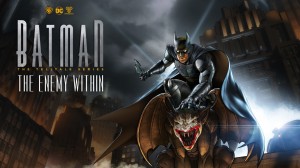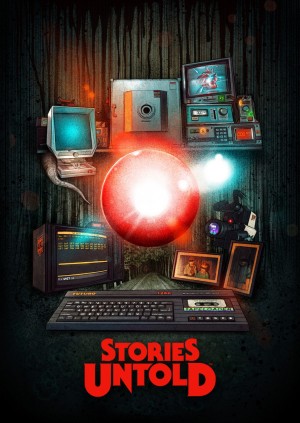Review for Batman: The Enemy Within – The Telltale Series: Episode One – The Enigma

It’s been less than a year since Telltale wrapped up the first season of their Batman series, but already the caped crusader is back for more in The Enemy Within. Crime never rests in Gotham. While that’s no good for Bruce Wayne, it’s all the better for us. Based on the first episode alone, The Enigma, this is an improved experience that takes everything that worked beforehand and applies slight upgrades. There are still things that are lacking, most noticeably the absence of any real challenge, but that has become par for the course when it comes to Telltale’s modern output. Nevertheless, if you’re looking to both brawl as Batman and battle public perception as Bruce Wayne, this debut instalment tells an intriguing tale that sets a solid stage for what’s to come.
It starts out harmlessly enough: A suave man kitted out with high-tech gadgets is scouting a casino floor. No, this isn’t James Bond, though it’s an obvious comparison to make. This is Bruce Wayne, keeping an eye on the plump Rumi Mori, a magnate who made his money through arms dealing and has now diversified into biotech. With his trusty butler and surrogate father Alfred talking into his ear from the Batcave, our protagonist is here to try to find evidence of Mori’s shady dealings, and you do some light detective work by clicking highlighted objects to get Bruce’s thoughts on them.
Of course, it doesn’t take long for everyone in the casino to get more than they bargained for when a man in a green hood and domino mask bursts onto the scene posing the question: “I begin and have no end. And I end all that begins. Who am I?” The answer to that conundrum is Death – or as you’ll come to know him, Riddler. Portrayed countless times across comics, television and film through the years, this take on the enigma-obsessed villain is a great one. With his greying hair, growling voice and metal-hooked cane, we learn that the Riddler terrorised Gotham in the past, only to suddenly disappear. He’s clearly wanting to make strong impressions upon his return, immediately slashing throats and destroying buildings to wreak havoc. This is a violent, scary portrayal of a man who may not have Batman’s strength, but has an equal amount of ingenuity.
There’s no time for polite introductions. With the threat level red, Bruce switches into his alter ego and dons his powerful black suit. The last Batman season had superb action sequences and it’s no different this time. With the music beating in the background, Batman jumps, kicks and punches seemingly with ease. From a gameplay perspective, the fights mostly consist of pushing the right buttons when prompted, though there’s a neat new element that lets you make tactical decisions on the fly, like choosing how to protect a hostage or take down an enemy. Previously this was planned in advance, leaving you to watch the results play out, but doing it in the moment is much more effective and maintains a stronger pace.
What particularly stands out during these combat sequences is the audio-visual presentation. These scenes make constant but effective use of slow motion, holding on a stylish shot while you push the corresponding on-screen buttons. Every bit of physical contact is keenly felt, the flying blood and loud thuds lending authenticity to the pain. And thanks to quick (yet never disorientating) camera switches and spins, along with Batman’s penchant for gadgets and his repertoire of fight moves, these encounters never grow stale. There are only a couple of these full-blown action sequences in this first episode, but they’re a joy to behold and engaging to play.
Riddler isn’t the only foe you’ll encounter. Sticking its nose into everything is a mysterious and unnamed agency, helmed by the no-nonsense Amanda Waller. This stout, middle-aged woman has her fingers in many pies, gathering intelligence not only on Gotham’s scum, but also on Bruce and Batman. She rubs Commissioner Gordon the wrong way, overruling him and taking over his cases. Her agency’s presence proves interesting in a subversive way: here is an entity that proves threatening for Batman because of the information and power they hold, and how you respond to it will impact your relationship with Gordon. It’ll be exciting to see how this plays out, especially after a key exchange you share with Waller.
Still on the periphery is John Doe, the green-haired, wild-grinned young man we were introduced to at the end of last season, now free of Arkham Asylum. He’s clearly going to become the Joker, unless Telltale pulls the rug, but here he’s not yet a mass-murdering lunatic like the character is traditionally portrayed. Instead, while slightly unstable, John is more socially inappropriate than anything. His wide eyes suggest menace, as does his unhealthy latching onto Bruce, but there’s no solid proof that he’s up to no good… yet. Thanks also to strong voice acting, which sounds like a man who could fly off the hook at any moment, I really like the character of John. I’m crossing my fingers that he doesn’t progress down the obvious route, turning evil from the rejection of Bruce, but we’ll hopefully be seeing much more of him soon.
As is standard for Telltale’s gameplay, you guide most of these encounters by selecting one of four dialogue options against the clock. It’s certainly nothing new at this point, but I still find it an enjoyable way to experience the story. For example, you can choose whether to be coy, direct or threatening, and those you’re engaged with will react accordingly, but your responses often only impact the next couple of lines. Then there are those choices that hold greater weight: Do you lie to a loved one or tell them the harsh truth? Do you choose to reveal key intel to Waller? Such dilemmas often demonstrate immediate consequences and could even impact future episodes too. You’ll ponder and overthink every one of these decisions, which is a credit to the strong characters and world-building on display.
This is all made believable thanks to the mostly strong writing. There are a few clumsy lines, particularly those shoehorned in for exposition, but each character you meet is well-defined. You feel like you’re interacting with distinct personalities, plus playing both sides of Bruce and Batman adds welcome depth – as the former you’re the smooth businessman, the latter a fierce vigilante. (Nothing is cooler than when you get the chance to silently grapple away from someone as Batman.) And while this is a serious take on the character, there are a couple moments of light relief, like when John awkwardly tries to squeeze around Bruce. It’d be good to see a bit more humour in future episodes because it works nicely in contrasting the darkness.
Receiving a notification that a character “will remember that” has been a common staple of Telltale’s games for a long time, but now there’s a new message added to the mix – that your relationship with someone has changed. In practice it means the same thing, since it doesn’t alter any of the gameplay (at least, not directly), but at the end of the episode you’ll get a summary of how you’ve affected some people and why. For example, I helped John become hopeful and I saw Gordon become steadfast. This is a neat wrinkle and I’m keen to see how this changes my interactions with these characters in the future.
When you’re not talking or fighting, you’re being a detective. Sadly, this is the weakest part of the experience. The concept is fine, but the execution falls flat. The process involves linking elements together to solve a mystery. For example, you discover a body at a crime scene and need to work out what caused the death. The problem is that you don’t need to use logic here at all – just examine everything (there are no optional hotspots) and then link them together in obvious pairs. You could argue this is as much engagement as the Quick Time Events are in the action scenes, but I crave some sort of challenge to make me feel like I’m tapping into the vaunted brain of our protagonist.
This is made worse by the fact that the Riddler is a central presence. His whole modus operandi is presenting enigmas – he’s arrogant, thinking he’s outsmarted you, so cracking them can advance your investigation or even save your life. This is the perfect setup for some thought-provoking challenge, but at least so far it’s entirely wasted. Near the beginning of the game you’ll get one of his mechanical boxes, adorned with a question mark, and answering a riddle can help you open it. But when it’s solved by interacting with one of the only nearby hotspots, one which you pointedly used only minutes before, it’s eye-roll inducing. I know difficulty has never been the primary concern of these interactive tales, but more effort should have been made where the situation actually warrants it.
As you might expect from a Batman adventure, much of the game is set at night or in darkly lit rooms, which works in favour of the art style. The Dark Knight himself looks downright awesome whenever he appears in his full suit with glowing eyes. The thick outlines and simple textures add to the comic book aesthetic, despite the realistic setting of most locations like a church and ship. These places feel rundown and grimy, which suits this universe. However, there's a missed opportunity when it comes to one key location involving Riddler. What we get is serviceable, but it would have been better to push the boundaries here a bit more. I get that the depiction isn’t meant to be fantastical, but the environment you explore isn’t particularly interesting, largely making clichéd use of some TV sets.
Regular composer Jared Emerson-Johnson is back again, dishing up another excellent score. During a sombre investigation, strings slowly strum and echo in the background, with soft drums building in as you progress. Elsewhere, throughout a trying conversation there’s a more electronic and reverberating approach, adding tension to the scene. The standout piece is probably during the opening fight, a fast-paced orchestral track that keeps the urgency and crescendos in perfect time with the action.
It shouldn’t need to be mentioned as a positive, but it’s certainly worth noting that I experienced no technical issues with this first episode. (Although I didn’t start playing until after an initial update, so I’m not sure what the immediate experience was like.) The previous season was plagued with slowdowns for me, even on powerful computers, but thankfully that’s vanished here. While the lip syncing could do with some improvement, this is a definite step in the right direction.
Clocking in at a little over two hours, The Enigma is a compelling debut for the second season of Telltale’s Batman. It’s packed full of interesting characters, and the way you can alter your relationships with them is often powerful. I had my reservations about how certain plot points evolved over the course of the first season, with the writing declining as it went on, so I’m hoping lessons have been learnt. So far so good. Enthralling action, engaging conversations and excellent audio are the highlights here, though more challenge certainly wouldn’t have gone amiss. With a delightful cliff-hanger that teases some juicy developments to come, I’ve got my mask and cape ready for further fun.
WHERE CAN I DOWNLOAD Batman: The Enemy Within – The Telltale Series
Batman: The Enemy Within – The Telltale Series is available at:
- GOG -60%
- Steam
- HumbleBundle






























